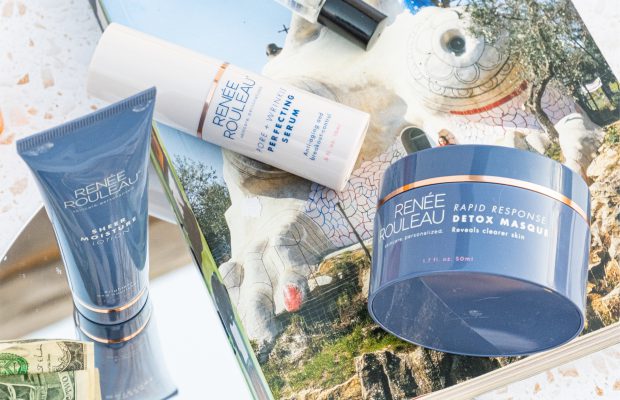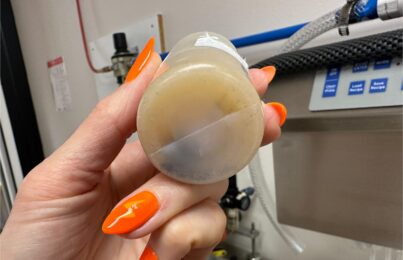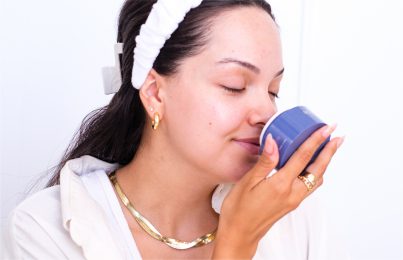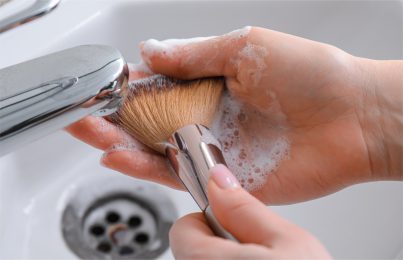Now more than ever, people are seeking out trustworthy information to help them make healthy choices and live their best life—and skincare is no exception. You are surely aware of terms like “organic,” “all-natural,” “non-toxic,” and “clean.” These can be summed up under an umbrella term, “clean beauty.”
Clean beauty has become a huge industry in the past few years; the demand is higher than ever before. However, a lack of regulation has allowed some beauty brands to make unsubstantiated claims for the sake of marketing. And as a consumer, it can be confusing to cut through all the noise. You might wonder whether you’re making the best decisions when it comes to your skin health & wellness in general.
In this post, I’ll share my personal thoughts on how to make sense of “clean beauty.” My hope is that this post will help you make the safest, healthiest choices for yourself without sacrificing great results for your skin!
What Is Clean Beauty?
There are no official regulatory guidelines that define “clean beauty,” so every skincare brand can have its own definition of what it means to them. With that being said, the general idea behind clean beauty is that a company is being thoughtful and ethical about the ingredients it chooses to use (or not use) in its formulations and how they’re sourced. These choices may be based on actual scientific studies, the brand’s own research, or simply on a gut feeling or opinion the brand has about certain ingredients. For example, the skincare brand Drunk Elephant avoids what they refer to as the “Suspicious Six:” six ingredients they believe to be harmful to overall skin health—whether it’s substantiated or not. It all just boils down to the ethos of a brand and what they choose to believe. Every brand has a right to its own opinions.
Is Clean Beauty Here to Stay or Is It Just a Trend?
Having been an esthetician for over 30 years (and a skincare formulator for 20+ of them), I have seen many trends come and go—only a few stayed. For example, topical vitamin C and exfoliating acids were “trends” when they first came on the scene two decades ago and are now the mainstays of a comprehensive skincare routine. On the other hand, using high percentages of essential oils in skincare products (pioneered by Aveda back in the late ’80s) has already come and gone a few times. This trend currently seems to be making a comeback with so many “natural” indie brands, but I think it will be heading out again soon. After all, high amounts of fragrant, essential oils can be very irritating to many people, especially those that use retinol and exfoliating acids on a regular basis.
As for clean beauty, I can confidently say that soon we won’t be attaching the word “trend” to it, which is a great thing. All skincare products should absolutely be focused on safety for both the skin and overall health. Transparency in skincare products will be the new norm as consumers demand that brands step up to the plate and share what is being used in their products.
The Safety of Skincare Ingredients
Are Chemical Ingredients Safe?
The word “chemical” has a negative connotation. Some brands know this and, unfortunately, purposely use it to make you fearful. Let me offer some insight. For starters, chemicals aren’t just found in chemistry labs. Our world and everything in it is made up of chemicals (with the exception of heat, gravity, kinetic energy, ultraviolet light, and the thoughts in our brains). This means that almost everything—including people, plants, and animals—is made up of chemicals. Scientific nerd fact: A chemical occurs when two or more atoms are held together by a chemical bond. This means that all skincare ingredients are considered chemicals, and there is actually no such thing as a “chemical-free” skincare product. Anyone who tries to tell you otherwise is being dishonest or is simply misinformed.
With that being said, there are chemicals out there that could potentially be harmful to your health but much of it still requires more research. For example, in 2020, California passed a bill that restricts the use of 24 ingredients in cosmetics. Of course, this doesn’t necessarily mean products that contain some of these ingredients are truly detrimental to your health (and some of these ingredients were never used in cosmetics anyway), but it does underscore what I’ve said time and time again, which is that it’s so important to buy products from a company you trust! The reality is that cosmetics are pretty safe.
“There is actually no such thing as a “chemical-free” skincare product and anyone who tries to tell you otherwise is being dishonest or is simply misinformed.”
Are Natural Ingredients Safer?
The term “natural” only indicates the source of an ingredient. It does not mean it’s chemical-free or even safe. In fact, many natural ingredients have not gone through the rigorous testing that synthetic ingredients have been put through, so we have not fully discovered any potential side effects.
Because of this, we tend to think of natural ingredients as safe, but this isn’t necessarily the case. For example, a “natural” product that chooses to shy away from more tried-and-true synthetics may be more likely to be recalled from shelves due to the formation of mold and instability (separating). The brand Herbivore issued a recall for moldy products, as did May Lindstrom. The uncommon preservative systems they chose didn’t hold up. The last thing anyone wants to see when they open a jar of face cream is mold (yuck!) let alone adding bacteria to your skin and putting your microbiome (healthy bacteria) in a major state of shock.
I’m hearing about this more and more as brands (particularly the smaller, newer indie ones) experiment with less-studied ingredients. I mean think about it…if a product was well-researched and had gone through scrutinous micro-testing, these products would never have been released to the public. Essentially, your face might be the guinea pig. When there is a problem, they are like, “oops, well that didn’t work out so well! Now we know!”
While I have taken many cosmetic chemistry classes through the years, and consider myself fairly well-versed in ingredients, I do rely heavily on my trusted chemists for guidance. They are experts on ingredients and are constantly staying on top of their related studies. If a new study about an ingredient’s safety or performance becomes available, they promptly inform me.
What Is “Greenwashing,” and Why Is It an Issue?
While a lot of brands choose to go the route of “clean beauty” because of their values and beliefs, other companies are simply capitalizing on this movement with misleading marketing. I see and hear about it constantly, and it’s really disappointing. For example, a brand may try to make a product seem more appealing by excluding ingredients that have long names and are difficult to pronounce. They pass them off as harmful even if there is no research showing that these ingredients adversely affect people’s health. As I mentioned with chemicals, some brands sadly use fear to market their lines by making you afraid of ingredients that have no proven negative side effects. Terms I mentioned earlier, like “non-toxic” or “all-natural,” aren’t regulated and don’t have any official meaning, which means companies can use them in a misleading way.
Another example is when I recently saw that a brand launched a new retinol product, and when I went to their website to check it out, I noticed the following listed on every single one of their product pages:
“WHAT IT IS FORMULATED WITHOUT: Animal Fats/Oils/Musks, Benzalkonium Chloride, Benzophenone, Bisphenol A (BPA), Butoxyethanol, BHA, BHT, Chemical Sunscreens, Coal Tar Dyes, 1,4-Dioxane, -Cones, Detergent, Essential Oils, EDTA, Ethanolamines (MEA/DEA/TEA), Formaldehyde, Fragrance, Hydroquinone, Liquid Paraffin, Liquid Petrolatum, Methyl Cellosolve, Methylisothiazolinone, Methylchloroisothiazolinone, Mercury, Mercury Compounds, Mineral Oil, Oxybenzone, Parabens, Paraffin Oil, Phthalates, Polyethylene Glycol (PEGs), Resorcinol, Retinyl Palmitate, Siloxanes, Sulfates, Thimerosal, Toluene, Triclosan, Triclocarban.”
I rolled my eyes when I read this, simply because many of the ingredients they listed wouldn’t logically be included in the type of product being promoted on that page anyways. It just rubbed me the wrong way that they would list every ingredient under the sun to make it seem like they went to great lengths not to include them. On my product pages, I only list the formulated without ingredients where I could have done so if I wanted to.
What Is “Science-Washing,” and Why Is It an Issue?
Just as there can be some shadiness when making claims on the green side of beauty, the same holds true on the science side. When brands dive deep into scientific findings, it can be over the average person’s head and tough to validate any claims being made. As someone who attempts to understand scientific research, I know personally how very, very challenging it is to decipher scientific papers. I often see and hear claims being made that may not be completely valid.
Ingredients I Choose to Avoid in Renée Rouleau Products
When I formulate a product, I consider the intent of the product (which problem it’s solving), the ingredients I want to use to drive results, and the ingredients I want to avoid using. I have many different reasons for avoiding the use of certain ingredients in my range. It may be a gut feeling based on the history of an ingredient’s use. It may be the fact that an ingredient is potentially harmful or sensitizing to the skin, or it may be that an ingredient is simply not beneficial to the integrity of the skin.
When it comes to researching ingredients, there is no shortage of websites that discuss them in both a positive and negative light, and I recognize that it can be confusing to decide which source to trust. As a skincare formulator, it’s my job to sort through all of this information and review related scientific studies to ensure I’m delivering safe products for my customers. Furthermore, I personally study ingredients closely and make this a part of my continuing education so I can stay up-to-date on the latest advancements and findings.
For example, these are some common ingredients I currently avoid using in Renée Rouleau toners:
- Quaternium-15
- Mineral Oil
- Petrolatum
- SD Alcohol 40 and Denatured Alcohol (these are drying alcohols, not to be confused with “good” alcohols)
- Sodium Laureth/Lauryl Sulfate
- Ammonium Laureth/Lauryl Sulfate
- Polyethylene beads (plastic)
- *Parabens (Ethylparaben, Butylparaben, Propylparaben)
- Phthalates (Dibutyl Phthalate, Diethyl Phthalate, Bisphenol)
- Hydroquinone (although I am not against this ingredient for those who have really stubborn melasma)
- Synthetic dyes
- Artificial fragrances
- Apricot kernels and seed/shell powders
*Note: I do have one product in my line that contains methylparaben which I formulated back in 2000 back when methylparaben was commonplace in formulas: Weightless Protection SPF 30. This sunscreen is one of our top-selling products because it’s so lightweight and wearable for everyday use. It’s perfect for those with breakout-prone and sensitive skin. If I removed the methylparaben, the formula would change entirely and wouldn’t feel as great on the skin, which would make our customers really unhappy. While Parabens have gotten a bad rap in recent years, the truth is there just isn’t any solid evidence proving that they’re harmful. Many people will tell you differently, but true experts will say it is still unknown. There is a lot of talk in the chemistry world about bringing them back into cosmetic formulations, because not only is there a lack of valid proof for their unsafety, but they lend formulas stability that is missing from some of the “natural” brands. Some of the lesser-studied, Paraben-free alternatives are what have allowed microorganisms to grow in products.
Also, I want to mention one other thing about our Weightless Protection SPF 30 since some of you have asked us. There was a recent ban in Hawaii for the sunscreen ingredients oxybenzone and octinoxate. They are thought to pose a risk of degrading coral reefs when worn while swimming in the ocean. This ban applies to water-resistant beach sunscreens only, which our sunscreen is not. Weightless Protection SPF 30 is a daily use sunscreen for under makeup. (Pro tip: When at the beach, wear long-sleeve UV protecting swimwear to lessen sunscreen getting into ocean waters in the first place.)
I do use silicones in formulas when it makes sense to do so. Silicones are also being debated. Here are some common misconceptions.
Why I Consider My Line to Be “Clean Beauty”
Based on my own definition, I would definitely consider my line to be “clean beauty,” because I am very conscientious about the safety of the ingredients I use. However, if I had to pick a label for my brand, I would actually say we are a “clean science” brand. What this means is that our products are thoughtfully formulated to be solution-focused and that they combine the finest of what both nature and science have to offer.
Why I Would Never Make My Line “All-Natural” (Science is Needed!)
At the end of the day, everyone wants results from their products. I believe tapping into science is the best way to achieve this. That being said, it’s important to understand that you don’t have to compromise your health in order to use products that tap into scientific advancements. I think a lot of brands are missing out on great opportunities when it comes to science-based skincare, and because of this, their products may not be very effective. Trust me, when you have serious skincare concerns like loss of tone, brown spots, wrinkles, or stubborn breakouts, applying a simple, “all-natural” face oil will only get you so far.
Another reason I would never make my line “all-natural” is that this is such an exciting time for beauty with incredible advancements in skincare technology. There is tremendous scientific brainpower dedicated to research and development, and in the past 25 years, we have learned so much about how the skin works. Product formulations are becoming more sophisticated than ever, allowing us to create real, meaningful change in people’s skin. Being the skincare nerd that I am, I would never want to miss out on all this, and I would never want my customers to miss out, either!
As I’ve said, I believe there are benefits to harnessing both science and nature in skincare. So, in my line, I will continue to embrace the best of both. There will undoubtedly continue to be medical advancements that expand into the field of skincare. I’m so excited to keep sharing them with you!
Final Thoughts
- One of the reasons people choose to buy from smaller, indie brands is that they are direct-to-consumer. This means their products are not sold in retail stores, which allows them to maintain better quality control. For example, whenever you buy a product from Nordstrom or Sephora, you can’t know how long the product has been sitting on a shelf. That’s why it’s important to pay attention to expiration dates (if they are listed) to ensure you’re getting a fresh product.
- Since we are a direct-to-consumer brand, we ship right from our facility to your front door. This gives us much more control over the safety and efficacy of our products. We ship from our facility in Austin, Texas. From time to time, we hear people are worried about ordering from us in the summer. They are concerned about their products sitting in the back of a delivery truck in the heat. No need to worry! Read what happens if your skincare products get hot.
- We never cut corners or use low-quality ingredients. We would never sell anything that we wouldn’t use on ourselves. Ultimately, it’s up to you as a consumer to decide what’s best for you. Although, I do hope that this information helps you make informed decisions.
- Regardless of an ingredient’s source, your skin won’t know where it came from. An ingredient either performs or doesn’t once it comes in contact with the skin. (As for the latter, read why I’m not a believer in DIY skincare.)
- Even scientific studies have limits. Take in vitro testing, for example. This has been a major advancement in beauty, and a necessary one, due to a decrease in animal testing. That said, using skin tissues in a petri dish can’t totally confirm that an ingredient will work exactly how it’s supposed to. It’s simply not always accurate. Human skin, when exposed to the environment, will act differently than it will when isolated. This is why, no matter how much research you do on a product, sometimes you just have to try it to see how it works for you.
What I love about clean beauty is the awareness it brings. Rest assured that there will certainly be more money spent on research, and as always, the skincare industry will continue to evolve. I sincerely hope you found this post helpful. The subject of clean beauty can be confusing, but I hope this brings a bit of clarity to the subject.
Next, here’s what you need to know about ingredient percentages (sometimes less is more!).
Celebrity Esthetician & Skincare Expert
As an esthetician trained in cosmetic chemistry, Renée Rouleau has spent 30 years researching skin, educating her audience, and building an award-winning line of products. Her hands-on experience as an esthetician and trusted skin care expert has created a real-world solution — products that are formulated for nine different types of skin so your face will get exactly what it needs to look and feel its best. Trusted by celebrities, editors, bloggers, and skincare obsessives around the globe, her vast real-world knowledge and constant research are why Marie Claire calls her “the most passionate skin practitioner we know.”




Comments:
This is a fantastic post! I really appreciate the in-depth analysis about this topic. Your insights have given me a new perspective. Thanks again for sharing your knowledge.
Posted By: som extracts |
wow such a nice explanation and so much important tips and knowledge about this impressive topic. its so satisfying and full of knowledge. thank you so much for this.
Posted By: iktaaromatics |
Thank you for your information.. Awesome
Posted By: Angels Cosmetics |
Thank you so much for this informative and helpful article! These are things I’ve been wondering about and you answered many of my questions!
Posted By: Lindy |
Glad you found it helpful!
Posted By: Renée Rouleau |